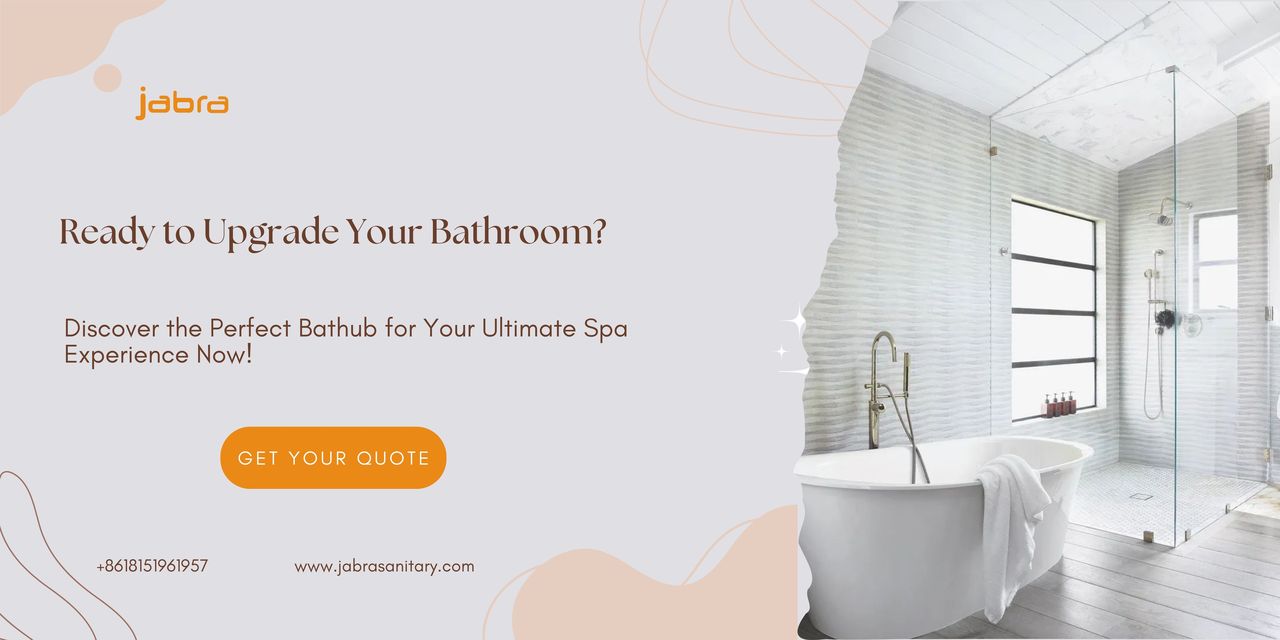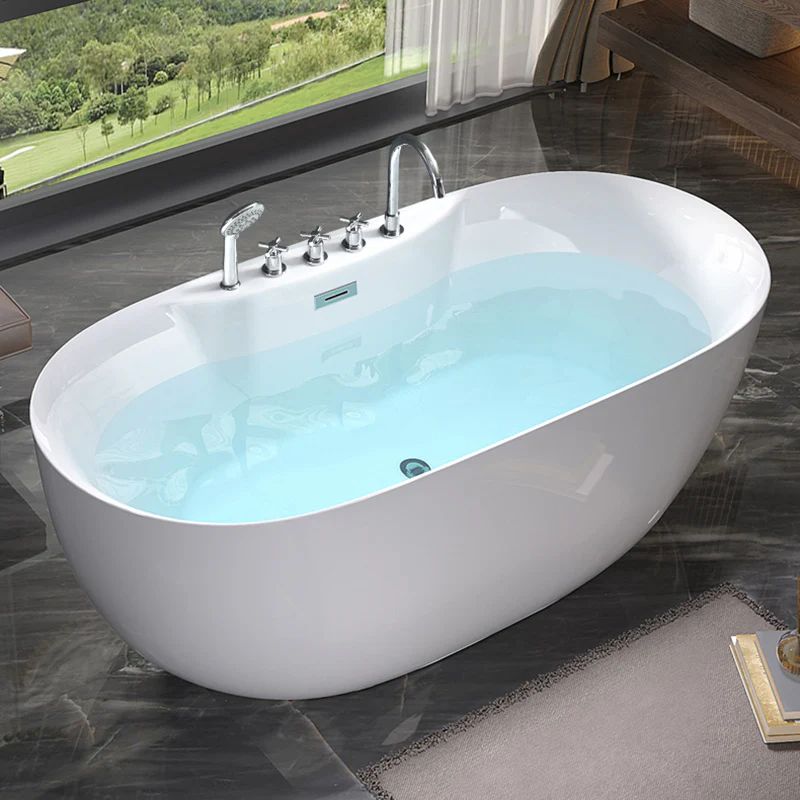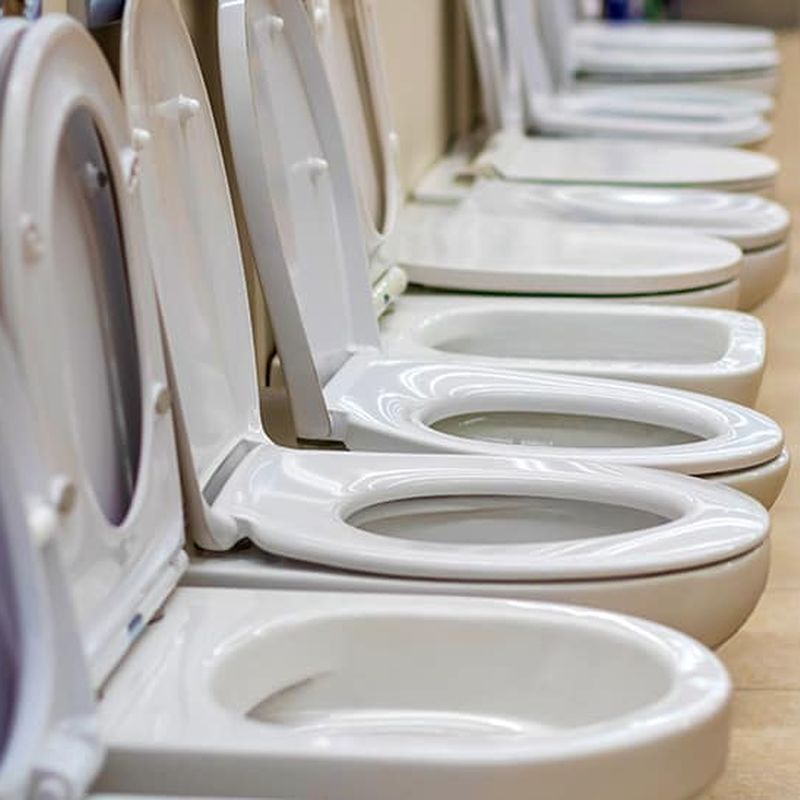 English
English
Jabra Sanitary is a sanitaryware supplier offering toilets, sinks, faucets, bathtubs, etc., at competitive prices. If you're a distributor, wholesaler, or project contractor, get a quote today!
 $23.9 Limited-time Offer
$23.9 Limited-time Offer Consignment Policy
Consignment Policy 20 Years of Experience
20 Years of Experience
If you've ever noticed that extra hole near the top of your bathtub and wondered what it's for, or if you're curious whether every tub comes with one, you've landed in the right spot. Over 80% of modern bathtubs include bathtub overflow drains, according to the National Kitchen & Bath Association.
Bathtub overflow drains might not be the flashiest part of your bathroom, but they play a huge role in keeping things safe and dry. Imagine filling your tub, getting distracted by a phone call, and coming back to a flood. That's where this handy feature steps in to save the day.

Table of Contents
What is a Bathtub Overflow Drain?
Why is the Tub Overflow Drain Important?
Tub Overflow Drain Diagram and How Does It Work?
Types of Bathtub Overflow Drains
Parts of a Bathtub Overflow Drain
Different Drain/Overflow Assembly Mechanisms
Common Issues with Bathtub Overflow Drains
Do All Bathtubs Need an Overflow Drain?
FAQs
Conclusion
What is a Bathtub Overflow Drain?
A bathtub overflow drain is a clever safety feature built into most bathtubs to stop water from spilling over the edge. It connects to a hidden pipe system that redirects excess water to the main drain.
It's that small opening you might see near the top of your tub, often covered by a decorative plate or cap.
Its main purpose is to act as a backup, draining excess water when the tub gets too full. This helps prevent water from flooding your bathroom floor, saving you from potential damage or slippery hazards.
Why is the Tub Overflow Drain Important?
The tub overflow drain might seem like a small detail, but it plays a big role in keeping your bathroom safe, functional, and looking great.

Safety First
One of the main reasons overflow drains are essential is safety. If a tub overflows, water can quickly spill onto the bathroom floor, creating a slippery surface that's a recipe for accidents.
A fall in the bathroom can be serious, especially for kids or elderly family members who might be more vulnerable.
The overflow drain catches excess water before it can overflow, reducing the risk of slips and falls. It's a simple feature that helps keep everyone in your home safe.
Preventing Water Damage
Water damage is a homeowner's nightmare. If your tub overflows, water can seep into the floor, walls, or even the ceiling below, leading to costly repairs.
The overflow drain helps prevent all of this by draining away extra water before it becomes a problem. The EPA estimates that 13% of household water damage claims stem from tub overflows.
A Better Bathing Experience
Bathtub overflow drains also make your bath time more enjoyable. They help maintain a consistent water level, so you don't have to worry about the tub getting too full or too shallow. This means you can relax in the tub without constantly adjusting the water.
Plus, knowing that the overflow drain has your back lets you focus on unwinding, not on watching the water level.
Aesthetic Appeal
Overflow drains can also add to the overall look of your bathtub. Many designs come with stylish covers or plates that blend seamlessly with the tub's finish, enhancing the bathroom's aesthetic.
Whether you prefer a sleek, modern look or something more traditional, there's likely an overflow drain design that complements your style.
By the Numbers
To put it in perspective, water damage is one of the most common and costly issues homeowners face.
According to a study by the Insurance Information Institute, water damage claims are among the top reasons for home insurance payouts, often costing thousands of dollars to repair.
A bathtub overflow drain is a simple way to reduce the risk of such damage, making it a smart investment for any bathroom.
Tub Overflow Drain Diagram and How Does It Work?
In the previous sections, we learned what a bathtub overflow drain is and why it's so important. Now, let's dive a little deeper and explore how this clever feature works.
Visualizing the Overflow Drain System
To understand how the bathtub overflow drain works, it helps to picture the setup inside your bathtub. <See bathtub parts>

Near the top, usually a few inches below the rim, there's a small opening—this is the overflow drain. It's often covered by a decorative plate or cap, which might have slots or holes to let water pass through.
This overflow drain is connected to a pipe that runs down the side of the tub and joins the main drain pipe at the bottom. The main drain, of course, is the larger hole where water normally exits when you pull the plug.
Here's a simple breakdown of the key parts:
- The overflow drain: A small opening near the top of the tub.
- The overflow pipe: A tube that carries excess water downward.
- The main drain: The primary exit point for all the water.
How Does the Overflow Drain Work?
When you fill your bathtub, the water level rises. If you accidentally leave the faucet running or fill the tub too high, the water will reach the level of the bathtub overflow drain before it can spill over the edge.
If water doesnʼt drain from the overflow, check for blockages. At that point, instead of overflowing, the excess water flows into the overflow drain. From there, it travels down the overflow pipe and merges with the main drain system, safely carrying the water away without causing a flood.
Let's break it down into steps for clarity:
- Filling the tub: You turn on the faucet, and water starts filling the bathtub.
- Water level rises: As more water enters, the level gets higher.
- Reaching the overflow: If the water reaches the height of the overflow drain, it begins to flow into the drain hole.
- Draining excess water: The water travels down the overflow pipe.
- Joining the main drain: The overflow pipe connects to the main drain pipe, allowing the excess water to drain away safely.
Types of Bathtub Overflow Drains
There are a few main designs, each with its unique look and benefits. Knowing these differences can help you choose the perfect one for your bathroom or make sense of what's already installed.
Traditional Overflow Drain
First up is the traditional overflow drain, the most common type you'll spot in bathrooms. It features a small opening near the top of the tub, usually covered by a decorative plate or cap.
This cap has slots or holes that let water pass through. Behind it, a pipe connects to the main drain system, ensuring excess water has somewhere to go.
When the water level rises too high, it flows into the overflow opening and down the pipe, preventing any spills onto your bathroom floor.
If your bathroom has a classic vibe with traditional fixtures—like a pedestal sink or chrome faucets—this type blends right in.
Integral Overflow Drain
Next, we have the integral overflow drain, a more modern and stylish option. Unlike the traditional type, this one is built directly into the tub's structure. You won't see a prominent cap—instead, it might have a slim slot or a series of tiny holes along the tub's rim. It's all about keeping things subtle and seamless.
Excess water slips through these hidden openings and travels down an internal pipe to the main drain, doing its job without drawing attention. If you're dreaming of a spa-like bathroom with clean lines and a modern feel, this type would elevate the whole setup.
Side-Drain Overflow Systems
Finally, there's the side-drain overflow system, a less common but eye-catching choice. Instead of placing the overflow near the top, this design positions it along the side of the tub. You might see a vertical slot or a row of holes running down the tub's wall, offering a distinctive twist.
When the water reaches the side openings, it flows in and gets channeled to the main drain, keeping things under control. If you've got a vintage-inspired or standout tub that's the star of your bathroom, a side-drain system could complement its charm perfectly.
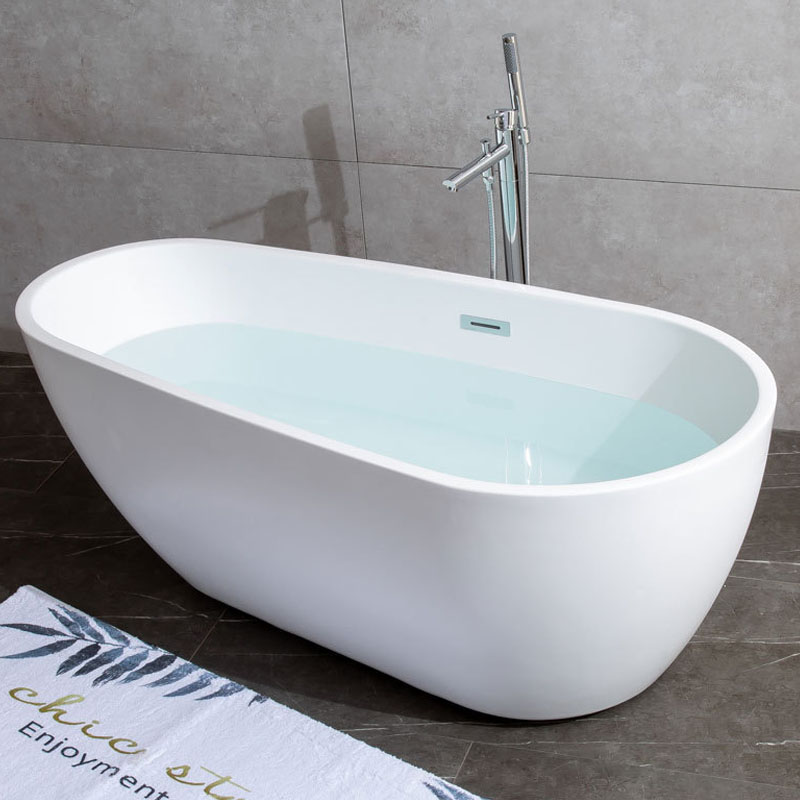 Ads
Ads
Small Stand Alone Freestanding Tub
This is the small stand alone bathtub Y03, the perfect addition to any small bathroom. This small bathroom free standing tub features a double-layer hollow design with four layers of material, ensuring excellent heat retention regardless of the season.
Parts of a Bathtub Overflow Drain
When we talk about a bathtub overflow drain, it's not just one simple piece—it's a system made up of several key parts working together to keep your bathroom safe and dry.
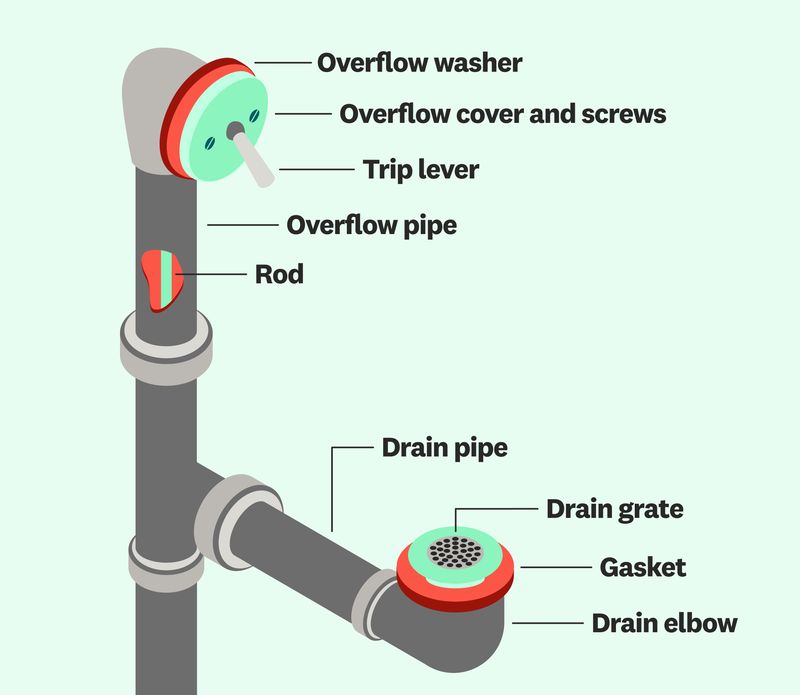
Overflow Cover and Screws
The overflow cover is the part we see inside the tub, usually a small plate or grate near the top, just below the rim. It's held in place by screws and can be taken off for cleaning or repairs.
This cover lets excess water flow into the overflow drain if the tub gets too full while keeping big stuff like hair or toys from clogging the pipe.
It's our first line of defense against overflows!
Overflow Washer and Rubber Gasket
Behind the overflow cover, we find the overflow washer and rubber gasket. These act like seals to stop water from leaking around the cover and into the walls or floor.
The washer, often made of rubber, squishes down to create a tight, watertight fit. If these wear out, we might notice leaks, so keeping them in good shape is super important to avoid water damage.
Overflow Pipe and Trap (P-Trap)
Next up is the overflow pipe, a tube that carries water from the overflow drain to the main drain system.
Connected to it is the P-trap, a curved pipe that holds a bit of water to block smelly sewer gases from sneaking back into the bathroom. P-traps must meet ASTM F409 specifications.
Together, they make sure excess water escapes safely and our bathroom stays fresh.
Waste Arm
The waste arm is the pipe that links the overflow and main drain to the home's plumbing, sending water out to the sewer or septic system. It's like the highway that water travels on to leave the tub.
Without it, water would have nowhere to go, and we'd be dealing with a messy backup!
Stopper Mechanism (Varies by Design)
Finally, there's the stopper mechanism, which controls whether water stays in the tub or drains out.
It can be a simple plug, a pop-up stopper we push with our foot, or a fancy trip lever tied to the overflow cover. Whatever the design, it's what lets us fill the tub for a soak and empty it when we're done.
Different Drain/Overflow Assembly Mechanisms
When it comes to bathtub overflow drains, the way they're controlled can vary. These drain/overflow assembly mechanisms let us fill the tub, hold water, and drain it when we're done.
The three most common types are the trip lever with pop-up stopper, trip lever with plunger, and cable drain.

Trip Lever with Pop-Up Stopper
The trip lever with a pop-up stopper is a familiar setup. It uses a lever on the overflow cover to move a pop-up stopper at the tub's bottom.
Flip the lever down, and the stopper seals the drain to fill the tub. Flip it up, and the water drains out. It's easy to use and widely recognized.
Trip Lever with Plunger
Next up is the trip lever with a plunger. This also uses a lever on the overflow cover, but it controls a plunger inside the drain pipe instead of a visible stopper.
Flip the lever down, and the plunger blocks the drain to hold water. Flip it up, and the water escapes. It's great for a sleek look with no stopper in sight.
However, hair or debris can clog the plunger, causing slow draining or leaks if it doesn't seal well.
Cable Drain
Lastly, we have the cable drain, a modern twist. It uses a cable linked to a knob or handle—usually on the overflow cover.
Turn the knob, and the cable moves a stopper or plunger to open or close the drain. It's low-maintenance and less likely to clog since there's no linkage in the drain pipe.
Common Issues with Bathtub Overflow Drains
Even though bathtub overflow drains are there to keep our bathrooms safe and dry, they can run into a few hiccups now and then.
Clogs
What is it?
Clogs happen when hair, soap scum, or other debris gets stuck in the overflow drain pipe, stopping water from flowing smoothly. Clogs account for 60% of overflow drain complaints.
How to spot it:
If our tub drains slower than usual or water starts backing up, we've likely got a clog. We might also hear gurgling noises or catch a whiff of foul odors from the drain.
What to do:
We can tackle a clog with a drain snake to pull out the blockage or try pouring a mix of baking soda and vinegar down the overflow drain to break things up. If that doesn't do the trick, a plumber can step in.
Leaks
What is it?
Leaks pop up when water sneaks out of the overflow system, usually because the gasket is worn out or the overflow cover isn't screwed on tight.
How to spot it:
Look for water dripping from the overflow area or wet spots on the floor or walls near the tub—that's a telltale sign of a leak.
What to do:
First, we can tighten the screws on the overflow cover. If the leak keeps going, the rubber gasket behind it might need replacing. It's a quick fix, but a plumber can help if we're unsure.
Corrosion/Rust
What is it?
Over time, metal parts in the overflow drain can rust or corrode from constant exposure to water and air, which might cause leaks or breakage.
How to spot it:
Check for discoloration, flaking metal, or a rusty smell around the overflow drain. Rusty screws or a worn-out cover are big clues.
What to do:
If we spot corrosion early, a rust remover might clean it up. But if it's too far gone, replacing the rusted parts—like the overflow cover or pipe—is the way to go.
Do All Bathtubs Need an Overflow Drain?
When we think about bathtubs, we often picture a relaxing soak, but safety is just as important as comfort. That's where the overflow drain comes in—it's a small but mighty feature that helps prevent water from spilling over and flooding our bathrooms.
PC Section 405.5 mandates overflow drains. But do all bathtubs really need one? Let's explore this question together.

First, it's worth noting that many bathtubs, especially standard ones in homes, come with an overflow drain. Plumbing codes in many areas, like the International Plumbing Code, actually require them for safety.
These codes exist to protect us from water damage and slippery floors, so in most cases, yes, bathtubs need an overflow drain to meet legal standards and keep things safe.
But what about modern or custom-designed tubs? Some sleek, stylish bathtubs might skip the overflow drain for a cleaner look. While this can be visually appealing, it doesn't mean the tub doesn't need one—it's just a design choice.
Without an overflow drain, there's a risk. If we forget to turn off the faucet or the drain clogs, water could overflow, leading to costly damage or a bathroom mess.
That said, there might be rare cases where an overflow drain isn't as critical. Think commercial settings where water levels are tightly controlled or tubs with alternative safety features. But for most of us at home, having an overflow drain is a practical choice.
FAQs
Bathtub overflow drains can raise a lot of questions, especially if you're new to plumbing or bathroom upkeep. Don't worry—we've got you covered!
How to install a bath overflow drain?
Here's a step-by-step guide:
- Gather your tools: You'll need a screwdriver, pliers, a plumber's putty, and a new overflow drain kit.
- Remove the old drain: Unscrew the overflow cover and disconnect the old drain assembly from the tub. You might need to scrape off old putty or caulk.
- Prepare the new drain: Roll the plumber's putty into a ring and press it around the underside of the new overflow flange.
- Attach the new drain: Insert the drain through the overflow hole in the tub and secure it with screws or clips from the kit.
- Seal it up: Ensure the putty creates a watertight seal to avoid leaks.
- Test for leaks: Fill the tub with water and check around the overflow drain for any drips.
Where should a tub drain be placed?
The overflow drain is typically positioned near the top of the bathtub, about 2-3 inches below the rim.
What does a bathtub overflow cover do?
The overflow cover is the visible piece of the overflow drain system. It has two main jobs:
- Protection: It keeps large objects like hair, toys, or soap bars from slipping into the drain and clogging it.
- Style: It can match your bathroom's look, adding a decorative touch. Most covers are removable for easy cleaning or maintenance. Some even include features like a trip lever to control the tub's stopper.
What is the diameter of a bathtub drain hole?
The size of a bathtub drain hole depends on which drain you're measuring:
- Overflow drain hole: Usually about 1.5 inches in diameter, just right for catching extra water.
- Main drain hole: Typically around 2 inches in diameter, designed for fast drainage.
How do I stop my bathtub from overflowing?
Try these tips:
- Watch the water: Stay nearby while filling the tub and monitor the level. A timer can help if you're prone to wandering off.
- Keep the overflow clear: Remove the cover now and then to clean out hair or debris. Pouring baking soda and vinegar down the drain can break up buildup.
- Add a water level alarm: These gadgets beep when the water gets too high, giving you a heads-up.
- Install an overflow if you don't have one: Not all tubs come with an overflow drain—talk to a plumber about adding one.
Conclusion
A bathtub overflow drain might not sound exciting, but it's a hero in disguise. Without it, a relaxing bath could turn into a stressful mess.
That's why we believe understanding and caring for this little feature is so important—it's all about keeping your home safe and your bathing experience enjoyable.
Of course, bathtub overflow drains aren't perfect. They can clog, leak, or rust over time. But with a little attention—like checking for blockages or wear—you can avoid most problems.
And if something does go wrong, or if you're thinking about upgrading your tub, we've got a recommendation: Jabra Sanitary. Our team knows overflow drains inside and out, and we offer top-notch products to fix or improve your setup.







